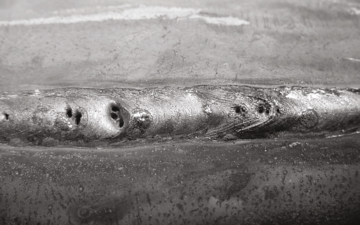Professional Guidance on What is Porosity in Welding and How to Resolve It
Professional Guidance on What is Porosity in Welding and How to Resolve It
Blog Article
Unwinding the Mystery of Porosity in Welding: Tips for Minimizing Defects and Optimizing Quality
In the complex globe of welding, porosity continues to be a consistent difficulty that can dramatically influence the high quality and honesty of bonded joints. Comprehending the factors that add to porosity formation is vital in the quest of remarkable welds. By deciphering the enigma of porosity and carrying out efficient strategies for flaw minimization, welders can elevate the standards of their work to achieve remarkable top quality outcomes. As we look into the depths of porosity in welding, discovering the keys to its prevention and control will certainly be extremely important for professionals seeking to understand the art of top quality weldments.
Comprehending Porosity in Welding
Porosity in welding, a typical problem encountered by welders, refers to the existence of gas pockets or gaps in the welded material, which can endanger the stability and quality of the weld. These gas pockets are typically caught throughout the welding procedure because of numerous elements such as inappropriate shielding gas, contaminated base materials, or incorrect welding specifications. The formation of porosity can damage the weld, making it susceptible to cracking and corrosion, inevitably bring about architectural failings.
Comprehending the source of porosity is essential for welders to efficiently stop its occurrence. By recognizing the value of maintaining correct gas securing, ensuring the sanitation of base materials, and enhancing welding settings, welders can considerably minimize the possibility of porosity formation. Additionally, utilizing techniques like pre-heating the base product, employing correct welding strategies, and conducting comprehensive inspections post-welding can even more assist in lessening porosity problems. On the whole, an extensive understanding of porosity in welding is necessary for welders to create premium and sturdy welds.

Typical Causes of Porosity
When examining welding procedures for possible top quality issues, comprehending the typical reasons of porosity is crucial for maintaining weld integrity and stopping architectural failings. Porosity, identified by the visibility of dental caries or gaps in the weld metal, can considerably jeopardize the mechanical homes of a bonded joint.
In addition, welding at inappropriate criteria, such as excessively high traveling speeds or currents, can create too much turbulence in the weld pool, trapping gases and triggering porosity. By attending to these usual reasons via appropriate gas securing, product prep work, and adherence to optimal welding parameters, welders can reduce porosity and enhance the quality of their welds.
Techniques for Porosity Prevention
Executing efficient preventative actions is crucial in reducing the incident of porosity in welding processes. One technique for porosity prevention is guaranteeing proper cleaning of the base metal prior to welding. Impurities such as oil, oil, corrosion, and paint can bring about porosity, so detailed cleansing making use of Get the facts proper solvents or mechanical approaches is necessary.

Utilizing premium filler materials and securing gases that are suitable for the base steel and welding procedure can considerably reduce the threat of porosity. Furthermore, keeping appropriate welding parameters, such as voltage, existing, travel rate, and gas flow rate, is essential for porosity avoidance.
Additionally, using appropriate welding techniques, such as preserving a consistent traveling speed, electrode angle, and arc length, can aid stop porosity (What is Porosity). Appropriate training of welders to guarantee they adhere to ideal techniques and high quality control procedures is likewise important in decreasing porosity issues in welding

Finest Practices for Quality Welds
One key method is keeping proper tidiness in the welding location. Extensively cleaning up the workpiece and surrounding location prior to welding can help alleviate these issues.
One more ideal practice is to thoroughly choose the suitable welding parameters for the specific materials being signed up with. Correct parameter selection ensures optimal weld penetration, fusion, and total quality. Utilizing high-quality welding consumables, such as electrodes and filler steels, can considerably influence the last weld quality.
Significance of Porosity Control
Porosity control plays an important role in guaranteeing the integrity and top quality of welding joints. Porosity, identified by the existence of tooth cavities or spaces within the weld metal, can dramatically jeopardize the mechanical homes and structural honesty of the weld. Extreme porosity compromises the weld, making it more prone to breaking, rust, and overall failing under operational loads.
Effective porosity control is important for maintaining the click over here desired mechanical properties, such as toughness, ductility, and sturdiness, of the bonded joint. What is Porosity. By reducing porosity, welders can enhance the total quality and dependability of the weld, ensuring that it satisfies the efficiency requirements of the designated application
In addition, porosity control is vital for accomplishing the wanted visual look of the weld. Excessive porosity not only damages the weld but likewise interferes with its aesthetic appeal, which can be important in sectors where aesthetic appeals are find essential. Proper porosity control strategies, such as using the appropriate protecting gas, regulating the welding parameters, and guaranteeing appropriate sanitation of the base products, are essential for producing top notch welds with marginal problems.

Conclusion
In final thought, porosity in welding is an usual problem that can jeopardize the top quality of the weld. By understanding the causes of porosity and applying proper prevention methods, welders can reduce flaws and achieve better welds. It is vital to regulate porosity in welding to make sure the integrity and stamina of the end product. Applying finest techniques for porosity control is critical for attaining optimum welding results.
Report this page